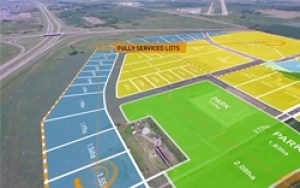Pilot Sound, a Walton Development and Management project, will consume 437 acres within the greater 11,861-acre park and will offer 974,350-square-feet of building space. Almost 40 acres of Pilot Sound has been pre-sold and the clients include a car dealership, a storage company and a manufacturer, said Jeff Grobman, vice-president industrial with Colliers International in Edmonton, the firm selling the lots.
The completion of Anthony Henday Drive — a ring road around the city – has made a huge difference, he added.
Travelling from Sherwood Park, to the east of Edmonton, to the industrial park used to take 40 minutes but now it’s closer to 16 minutes, he said, adding the area also offers easy access to the northwest and the south of the city.
“That was one of the biggest factors that people were looking for in the northeast was the ability to get around into the different major arteries fast and efficient,” Grobman said.
With full urban services such as curbs and gutters, street lamps and architectural guidelines, he said Pilot Sound is “going to be a showpiece, but it’s still a working man’s industrial park.”
One of the environmentally friendly features about the property is surface drainage into ditches, rather than a pipe system. The ditches will flow into a storm pond and the storm pond will outlet into an outfall that will flow into a creek.
“It’s less man-made infrastructure to manage stormwater. Through the ditch systems and the surface drainage, it allows for more ingress of the water back into the water table out there (rather) than putting it into concrete pipes where it has no chance to get back into the groundwater,” said Chris Davis, Walton’s general manager in Edmonton.
“Also through those ditches we can treat the water, so water quality is a very important aspect here.”
Davis added that further eco-industrial components have included discussions with end users about building orientation to maximize sunlight capture and the possibility of sharing byproducts.
The latter will depend on planning for synergies between nearby companies within the park.
“Just by having businesses that interact with each other and rely upon each other clustering together, that’s an eco-industrial principle,” he said.
“A conventional park would not even be thinking about that, and they (the industrial park occupants) would have to continue to drive across town for their various aspects of business.”
The environmental components of the park have not put undue pressure on pricing, which stands at $650,000 to $750,000 per acre and has been well received, stated Grobman.
“We’re not getting any resistance from it,” he said.
“We’ve had a lot of interest. It’s just a matter now of seeing the dirt move. As tough as business has been, there are still people looking to relocate.”
The Edmonton Energy and Technology Park is targeting petrochemical-based industries, manufacturers, logistics and transportation companies and engineering firms, among others.
According to the City of Edmonton, over the past 10 years, industrial land absorption has occurred at a rate of 341 acres per year.
For Pilot Sound, work to prepare zoning and subdivision applications began in 2011. Walton began the stripping and rough grading of the lots in 2012.
Sureway Construction Management was contracted for the bulk of grading activities, moving top soil, rough shaping of the storm pond and the water feedermain extension, Davis said.
“When we go back into the site for our next steps, it will be the fine-tuning of the grading, which would be getting every lot graded to their specifications and basically ready for the end users,” said Davis, adding he anticipates that next step will occur in early spring of 2017.
That will be followed by underground utility installation and surface improvements for phases one and two of Pilot Sound.
Walton Development and Management has other similar interests in Edmonton. They are behind Stony Industrial, which is also fully serviced and is comprised of 60 acres in northwest Edmonton.
Walton also has a hand in the 238-acre Henday Industrial Park, in partnership with WAM Development Group and Canada Pension Plan. There’s more than 600,000-square-feet of building space available in more of a “if you build it, they will come” model, Davis said.
Pilot Sound Industrial Park differs in the sense that it’s grooming the land to be sold to end users, who will oversee their own construction.
“There’s no leases. There’s no partnerships. There’s nothing else on the table at present. It’s a very conventional land development, selling to end user model there,” said Davis.
However, Walton is considering trying its hand at construction in one of the 80-acre blocks within Pilot Sound.
“Maybe standing up some of our buildings and looking to lease them out and doing a bit of a buy and hold asset instead of buy and sell,” Davis said.
This article originally appeared on Journal of Commerce.



